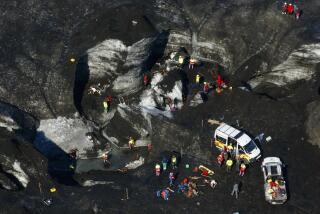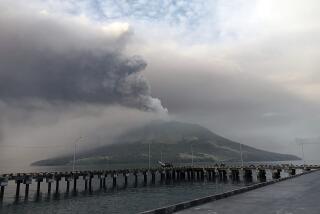Volcano ash keeps planes grounded across northern Europe
- Share via
Reporting from London — Planes across northern Europe remained grounded Friday as ash from an Icelandic volcano continued to waft through the atmosphere, with no firm predictions of when the eruptions -- and the travel delays -- would end.
Britain kept almost all of its airspace empty through the morning, allowing only a few flights to operate out of Scotland and Northern Ireland. Authorities said most non-emergency air travel would be banned through at least 7 a.m. Saturday London time, although a large part of Scotland’s and Northern Ireland’s airspace would be open to travel at 7 p.m. Friday.
Scandinavia also continued to keep most of its planes on the ground. By midday Friday, all major airports in Denmark, Sweden, Norway and Finland were scheduled to remain shut down for the rest of the day, with only a few small airports operational in the far north.
In France, the three main airports in Paris decided to allow inbound flights to land between 12 and 4 p.m. But no takeoffs were permitted, and other airports in northern France remained closed until at least 8 p.m. local time.
Belgium and the Netherlands also kept their skies empty of planes.
As the cloud of ash and dust moved east, flights were halted Friday at Frankfurt airport in Germany, Europe’s third-busiest terminal, and at 10 other German airports, including Duesseldorf, Berlin, Hamburg and Cologne, the Associated Press reported. No flights were allowed at Ramstein Air Base, a key U.S. military hub in the southwestern part of the country.
The Irish Aviation Authority reopened most of Ireland’s airspace Friday morning, except for a small area off the country’s southern coast. Passengers were able to fly again out of the major cities of Dublin, Shannon and Cork.
In Poland, airports were closed, leading to some doubt whether the state funeral of President Lech Kaczynski, who died in a plane crash in Russia last week along with his wife and other top Polish leaders, would take place as planned Sunday. President Obama was on the funeral’s guest list.
Also among those scheduled to attend the funeral are Russian President Dmitry Medvedev and German Chancellor Angela Merkel. Officials have said a postponement of the funeral would be an absolute last resort.
The White House says Obama still planned to fly to Poland on Saturday for the funeral.
The Associated Press reported that Kaczynski’s family wanted the funeral to go forward as planned.
“It is the will of the family that, under no circumstance, the date of the funeral be changed,” said Jacek Sasin
Eurocontrol, the European air traffic agency, said the flight disruptions that upended travel in Europe and reverberated throughout the world Thursday were even worse Friday. Half a dozen European nations have closed their airspace, the cloud was drifting east, about 60% of European flights were not operating and delays will continue into Saturday, it said.
“We expect around 11,000 flights to take place [Friday] in European airspace. On a normal day, we would expect 28,000,” said Kyla Evans, a spokeswoman for Eurocontrol. “The cloud of volcanic ash is continuing to move east and southeast.”
Ice chunks the size of houses tumbled down from a volcano beneath Iceland’s Eyjafjallajokull (ay-yah-FYAH’-plah-yer-kuh-duhl) glacier Thursday as hot gases melted the ice. The volcano began erupting Wednesday for the second time in less than a month.
As torrents of water roared down the steep slopes of the volcano, about 40 people nearby were evacuated because of flash flooding. More floods from melting waters are expected as long as the volcano keeps erupting, said Rognvaldur Olafsson of the Civil Protection Department.
The ash cloud, drifting between 20,000 to 30,000 feet high and invisible from the ground, left tens of thousands of travelers stranded around the globe and blocked the main air flight path between the U.S. East Coast and Europe.
Trains and hotels in key European cities were packed as people scrambled to make alternate travel plans.
No more than 120 trans-Atlantic flights reached European airports Friday morning, compared to 300 on a normal day, said Eurocontrol’s Evans. About 60 flights between Asia and Europe were canceled Friday, stranding several thousand passengers.
Sweden and Norway declared skies in the far north to be safe again for travel even as flights in both capitals -- Stockholm and Oslo -- were still on a lockdown. Aviation authorities in Ireland reopened airports in Dublin and Cork and lifted most restrictions on the country’s airspace.
Poland expanded its no-fly zone Friday to most of the country, excluding the southern cities of Krakow and Rzeszow. Anxious Polish officials worried that the ash cloud could threaten the arrival of many world leaders for Sunday’s state funeral of President Lech Kaczynski and his wife, Maria, in the southern city of Krakow.
Professor Jon Davidson of the department of earth sciences at Durham University in England said the dispersal of the cloud is dependent on the weather. The cloud can be blown elsewhere, the ash could all fall to Earth, or the ash particles could spread and become diluted, no longer posing a threat to aircraft, he said.
Britain’s Meteorological Office said the wind was expected to blow form the north, which would bring further ash across parts of Britain. Small amounts of ash settled in northern Scotland and Norway, but officials said there was little risk to health.
“It’s not toxic or poisonous, it’s not radioactive . . . and shouldn’t pose any danger to general health,” Scottish first minister Alex Salmond told the BBC.
Officials at the World Health Organization in Geneva disagreed, saying Europeans should try to stay indoors if ash from Iceland’s volcano starts raining down from the sky.
WHO spokesman David Epstein says the agency doesn’t know the exact health risks from the ash cloud. However, he said the ash is potentially dangerous if it starts to “settle” on the earth because inhaling the particles can cause respiratory problems, especially for those suffering from asthma and respiratory diseases.
Iceland, a nation of 320,000 people, sits on a large volcanic hot spot in the Atlantic’s mid-oceanic ridge, and has a history of devastating eruptions.
Explosive volcanic eruptions inject large amounts of highly abrasive ash -- essentially very small rock fragments -- into the upper atmosphere, the cruising altitude of most jet airliners. It can cause significant damage to both airframes and engines.
The U.S. Geological Survey said about 100 aircraft have run into volcanic ash from 1983 to 2000. In some cases engines shut down briefly after sucking in volcanic debris, but there have been no fatal incidents. Still, authorities are very wary, because ash cannot be detected by a plane’s normal weather radar.
In 1989, a KLM Royal Dutch Airlines Boeing 747 flew into an ash cloud from Alaska’s Redoubt volcano and lost all power, dropping from 25,000 feet to 12,000 feet before the crew could get the engines restarted. The plane landed safely.
In another incident in the 1980s, a British Airways 747 flew into a dust cloud and the grit sandblasted the windshield. The pilot had to stand and look out a side window to land safely.
The Associated Press contributed to this report.
More to Read
Sign up for Essential California
The most important California stories and recommendations in your inbox every morning.
You may occasionally receive promotional content from the Los Angeles Times.











